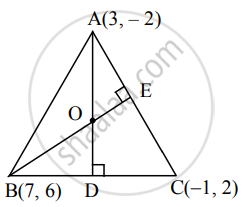Advertisements
Advertisements
प्रश्न
Find the co-ordinates of the orthocenter of the triangle whose vertices are A(3, –2), B(7, 6), C(–1, 2).
उत्तर

Let O be the orthocentre of ΔABC.
Let AD and BE be the altitudes on the sides BC and AC respectively.
Slope of side BC = `(2 - 6)/(-1 - 7) = (-4)/(-8) = 1/2`
∴ Slope of AD = – 2 ...[∵ AD ⊥ BC]
∴ Equation of line AD is
y – (– 2) = (– 2) (x – 3)
∴ y + 2 = – 2x + 6
∴ 2x + y – 4 = 0 .....(i)
Slope of side AC = `(-2 - 2)/(3 - (-1)) = (-4)/4` = – 1
∴ Slope of BE = 1 ...[∵ BE ⊥ AC]
∴ Equation of line BE is
y – 6 = 1(x – 7)
∴ y – 6 = x – 7
∴ x = y + 1 .....(ii)
Substituting x = y + 1 in (i), we get
2(y + 1) + y – 4 = 0
∴ 2y + 2 + y – 4 = 0
∴ 3y – 2 = 0
∴ y = `2/3`
Substituting y = `2/3` in (ii), we get
x = `2/3 + 1 = 5/3`
∴ Co-ordinates of orthocentre, O = `(5/3, 2/3)`
APPEARS IN
संबंधित प्रश्न
Write the following equation in ax + by + c = 0 form.
`x/2 + y/4` = 1
Write the following equation in ax + by + c = 0 form.
`x/3 - y/2` = 0
Show that lines x − 2y − 7 = 0 and 2x + y + 1 = 0 are perpendicular to each other. Find their point of intersection
Find the co-ordinates of the foot of the perpendicular drawn from the point A(–2, 3) to the line 3x – y – 1 = 0
Find the equation of the line whose X-intercept is 3 and which is perpendicular to the line 3x − y + 23 = 0.
Find the distance of the origin from the line 7x + 24y – 50 = 0
Find the distance of the point A(−2, 3) from the line 12x − 5y − 13 = 0
Find the distance between parallel lines 9x + 6y − 7 = 0 and 3x + 2y + 6 = 0
Find points on the line x + y − 4 = 0 which are at one unit distance from the line 4x + 3y – 10 = 0.
Find the equation of the line passing through the point of intersection of lines x + y − 2 = 0 and 2x − 3y + 4 = 0 and making intercept 3 on the X-axis
D(−1, 8), E(4, −2), F(−5, −3) are midpoints of sides BC, CA and AB of ∆ABC Find equations of sides of ∆ABC
O(0, 0), A(6, 0) and B(0, 8) are vertices of a triangle. Find the co-ordinates of the incenter of ∆OAB
Answer the following question:
Obtain the equation of the line which is parallel to the X−axis and 3 unit below it.
Answer the following question:
Obtain the equation of the line which is parallel to the X−axis and making an intercept of 5 on the Y−axis.
Answer the following question:
Find the distance of the origin from the line 12x + 5y + 78 = 0
Answer the following question:
Find the distance between the parallel lines 3x + 4y + 3 = 0 and 3x + 4y + 15 = 0
Answer the following question:
Find the equation of the line which passes through the point of intersection of lines x + y − 3 = 0, 2x − y + 1 = 0 and which is parallel X-axis
Answer the following question:
Find the equation of the line which passes through the point of intersection of lines x + y + 9 = 0, 2x + 3y + 1 = 0 and which makes X-intercept 1.
Answer the following question:
Find the distance of P(−1, 1) from the line 12(x + 6) = 5(y − 2)
Answer the following question:
Find points on the X-axis whose distance from the line `x/3 + y/4` = 1 is 4 unit
Answer the following question:
Find the distance of the line 4x − y = 0 from the point P(4, 1) measured along the line making an angle of 135° with the positive X-axis
A particle is moving in a straight line according to as S = 24t + 3t2 - t3, then the time it will come to rest is ______
The length of perpendicular from (1, 3) on line 3x + 4y + 10 = 0, is ______
The y-intercept of the line passing through A( 6, 1) and perpendicular to the line x - 2y = 4 is ______.
Let the straight line x = b divide the area enclosed by y = (1 - x)2, y = 0 and x = 0 into two parts R1(0 ≤ x ≤ b) and R2 (b ≤ x ≤ 1) such that `R_1 - R_2 = 1/4`. Then b equals ______
If a plane has x-intercept l, y-intercept m and z-intercept n, and perpendicular distance of plane from the origin is k, then _______.
The length of the perpendicular from the origin on the line `(xsinalpha)/"b" - (ycosalpha)/"a" - 1 = 0` is ______.
